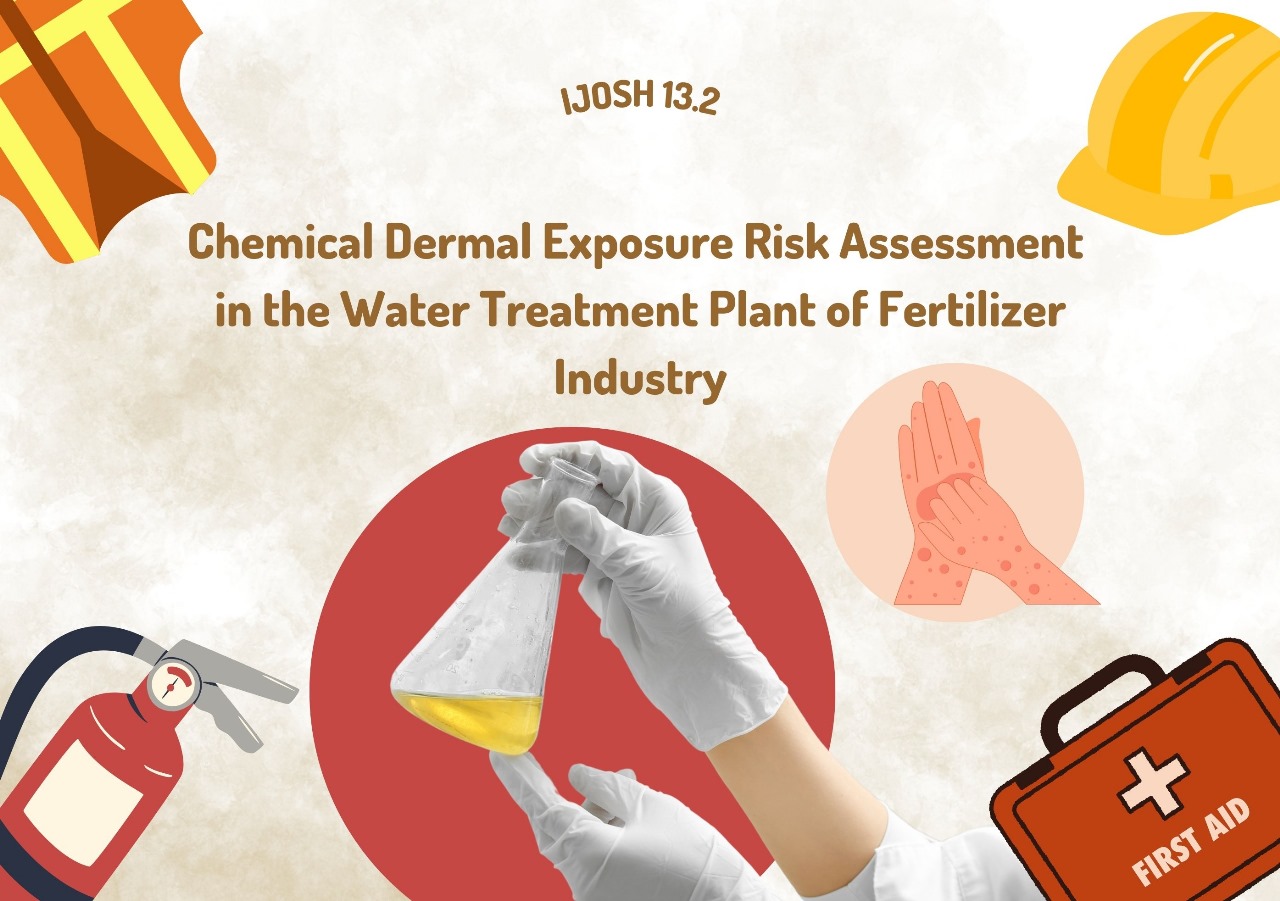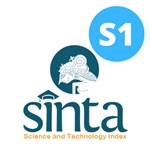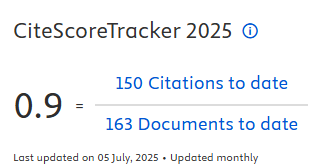Chemical Dermal Exposure Risk Assessment in the Water Treatment Plant of Fertilizer Industry

Introduction:In water treatment plants (WTP), chemicals play a crucial role. However, some of these chemicals are hazardous. This study aims to conduct a dermal risk assessment in the WTP of an ammonia and urea production facility. Methods: The study was performed in August 2023 and assessed dermal exposure risk for four hazardous chemicals: NaOCl (30%), HCl (60%), H2SO4 (98%), and NaOH (48%), utilizing the Tier 2 RISKOFDERM model. Intrinsic toxicity was evaluated using risk phrases and toxicity information. Potential dermal exposure rates (PERBODY and PERHANDS) were determined based on task group and exposure modifier, while actual dermal exposure rates (AERBODY and AERHANDS) were determined based on clothing type and activity time. Health risk was assessed using actual exposure scores and intrinsic toxicity levels, which were categorized into 10 different levels ranging from 1 to 10. Results: The risk phrases indicated that four chemicals possessed a high level of intrinsic toxicity in terms of local effect but no systemic effect. PERBODY and PERHANDS were high (NaOCl, HCl) and low (H2SO4, NaOH). The actual exposure scores were determined to be 1 (high) for NaOCl and HCI, 0.01 (low) for H2SO4, and 0.03 (medium) for NaOH. Health risk values were 8 for NaOCl and HCI, 5 for H2SO4, and 6 for NaOH. Conclusion: Health risks in NaOCl and HCl were assigned action priority (AP) 1, followed by NaOH at AP-2, and H2SO4 at AP-3. The study recommends the implementation of control measures encompassing engineering solutions, administration, and personal protective equipment.
Aslamiah, S, and Kurniawan, D. (2019) ‘Hubungan Pengetahuan dan Sikap Terhadap Kepatuhan Penggunaan Alat Pelindung Diri (APD) di PT. X’, Prosiding Seminar Nasional Kesehatan Lingkungan Menghadapi, Kebijakan Ilmu Kesehatan dan Farmasi Universitas Muhammadiyah Kalimantan Timur, pp. 42–45.
Chung, I., Ryu, H., Yoon, S. Y. and Ha, J. C. (2022) ‘Health Effects of Sodium Hypochlorite: Review of Published Case Reports’, Environmental Analysis Health and Toxicology, 37(1), e2022006.https://doi.org/10.5620/eaht.2022006
Crini, G. and Lichtfouse, E. (2019) ‘Advantages and Disadvantages of Techniques Used for Wastewater Treatment’, Environmental Chemistry Letters, 17, pp.145–155. https://doi.org/10.1007/s10311-018-0785-9.
Department of Occupational Safety and Health Ministry of Human Resources Malaysia (2018) A Manual of Recommended Practice on Assessment of The Health Risks Arising From The Use of Chemicals Hazardous to Health at The Workplace. 3rd edn.
ECHA (2023) Toxicological Summary - Sodium Hydroxide. Available at: https://echa.europa.eu/registration-dossier/-/registered-dossier/15566/7/1 (Accessed: 9 January 2024).
Falakh, F. and Setiani, O. (2018) ‘Hazard Identification and Risk Assessment in Water Treatment Plant Considering Environmental Health and Safety Practice’, E3S Web of Conferences, ICENIS 2017, 31. https://doi.org/10.1051/E3SCONF/20183106011
Franken, R., et al. (2020) ‘Ranking of Human Risk Assessment Models for Manufactured Nanomaterials Along the Cooper Stage-gate Innovation Funnel Using Stakeholder Criteria’, NanoImpact, 17, p.100191. https://doi.org/10.1016/J.IMPACT.2019.100191
Gitis, V. and Hankins, N. (2018) ‘Water Treatment Chemicals: Trends and Challenges’, Journal of Water Process Engineering, 25, pp.34–38. https://doi.org/10.1016/j.jwpe.2018.06.003
Han, D.-H.M.S.Y.-S.C. (2021) ‘Regulations on Wearing Personal Protective Equipment by Hazardous Chemical Handlers and Their Implementation’, Journal of Environmental Health Sciences, 47(1), pp.101–109. https://doi.org/10.5668/JEHS.2021.47.1.101
ILO (2021) ICSC 0482 - Sodium Hypocholrite (Solution, Active Chlorine <10%).
Kementerian Ketenagakerjaan RI (2022) Profil Keselamatan dan Kesehatan Kerja Nasional Indonesia Tahun 2022. Jakarta.
Kulkarni, P. and Jeffery, S. (2018) ‘The Effects of the use of Diphoterine® Solution on Chemical Burns in the Tarapur Industrial Complex, India’, Burns Open, 2(2), pp. 104–107. https://doi.org/10.1016/J.BURNSO.2018.03.001
Manzoor, A.F. (2020) ‘Core Competencies of Truck Drivers Responding to Emergencies During Transportation of Hazardous Materials’, Journal of Health and Pollution, 10(27). https://doi.org10.5696/2156-9614-10.27.200909
NIOSH (2023) Hierarchy of Controls. Available at: https://www.cdc.gov/niosh/topics/hierarchy/default.html (Accessed: 21 April 2024).
Noviarmi, F.S. and Prananya, L.H. (2023) ‘Hubungan Masa Kerja, Pengawasan, Kenyamanan APD dengan Perilaku Kepatuhan Penggunaan Alat Pelindung Diri (APD) pada Pekerja Area PA Plant PT X’, Jurnal Keselamatan Kesehatan Kerja dan Lingkungan (JK3L), 4(1), pp.57–66. Available at: http://jk3l.fkm.unand.ac.id/index.php/jk3l/article/view/71/59 (Accessed: 6 February 2024).
Occupational Safety and Health Administration (2018) Dermal Exposure - Overview. Available at: https://www.osha.gov/dermal-exposure (Accessed: 25 January 2024).
Oppl, R. Kalberlah, F., Evans, P. G. and, & van Hemmen, J. J. (2003) ‘A Toolkit for Dermal Risk Assessment and Management: An Overview’, Annals of Occupational Hygiene, 47(8), pp.629–640. https://doi.org/10.1093/annhyg/meg069
Pubchem (2023a) Hydrochloric Acid. Available at: https://pubchem.ncbi.nlm.nih.gov/compound/Hydrochloric-Acid#section=Hazards-Summary (Accessed: 11 December 2023).
Pubchem (2023b) Sodium Hydroxide. Available at: https://pubchem.ncbi.nlm.nih.gov/compound/Sodium-Hydroxide#section=Hazards-Summary (Accessed: 12 December 2023).
Pubchem (2023c) Sodium Hypochlorite Compound Summary. Available at: https://pubchem.ncbi.nlm.nih.gov/compound/Sodium-Hypochlorite#section=Hazards-Summary (Accessed: 11 December 2023).
Pubchem (2024) Sulfuric Acid. Available at: https://pubchem.ncbi.nlm.nih.gov/compound/Sulfuric-Acid#section=Toxicity-Summary (Accessed: 3 May 2024).
Riddick, J.M. (2020) ‘Hazards of Sodium Hydroxide’, Loss Prevention Bulletin, (271), p.13.
Saputra, A. and Widowati, E. (2023) ‘Relationship Between Predisposing Factors and Compliance with the Use of PPE (Personal Protective Equipment) Among Workers at Steel Industry of PT X’, Poltekita: Jurnal Ilmu Kesehatan, 17(02). https://doi.org/10.33860/jik.v17i2.2135
Schlueter, U. and Tischer, M. (2020) ‘Validity of Tier 1 Modelling Tools and Impacts on Exposure Assessments within REACH Registrations-ETEAM Project, Validation Studies and Consequences’, International Journal of Environmental Research and Public Health, 17(12). https://doi.org/10.3390/ijerph17124589
Slaughter, R.J., Watts, M., Vale, J.A., Grieve, J. R. and Schep, L.J. (2019) ‘The Clinical Toxicology of Sodium Hypochlorite’, Clinical Toxicology (Philadelphia, Pa.), 57(5), pp. 303–311. https://doi.org/10.1080/15563650.2018.1543889
Van Hemmen, J.J. (2005) ‘RISKOFDERM: Risk Assessment of Occupational Dermal Exposure to Chemicals’, Journal for Applied Occupational Health and Safety Science, 1.

This work is licensed under a Creative Commons Attribution-NonCommercial-ShareAlike 4.0 International License.

In order to be accepted and published by The Indonesian Journal of Occupational Safety and Health, Author(s) who submit an article should complete all the review process. The copyright of received articles assigned to the The Indonesian Journal of Occupational Safety and Health and Department of Safety and Health, Universitas Airlangga as publishers of the journal. The intended copyright includes the rights to publish articles in various forms (including reprints).
The Editorial Team of The Indonesian Journal Of Occupational Safety and Health and Department of Safety and Health strive to ensure that no errors occur in the articles that have been published, both data errors and statements in the article.
Users of this website will be licensed to use materials from this website following the Creative Commons Attribution-NonCommercial-ShareAlike 4.0 International License. No fees charged. Please use the materials accordingly.
------------------------------------------------------------------------------------------------------------------------------------------------------------------------------------------
Attribution ” You must give appropriate credit, provide a link to the license, and indicate if changes were made. You may do so in any reasonable manner, but not in any way that suggests the licensor endorses you or your use.
NonCommercial ” You may not use the material for commercial purposes.
ShareAlike ” If you remix, transform, or build upon the material, you must distribute your contributions under the same license as the original.







 How to Submit Articles in OJS
How to Submit Articles in OJS

























